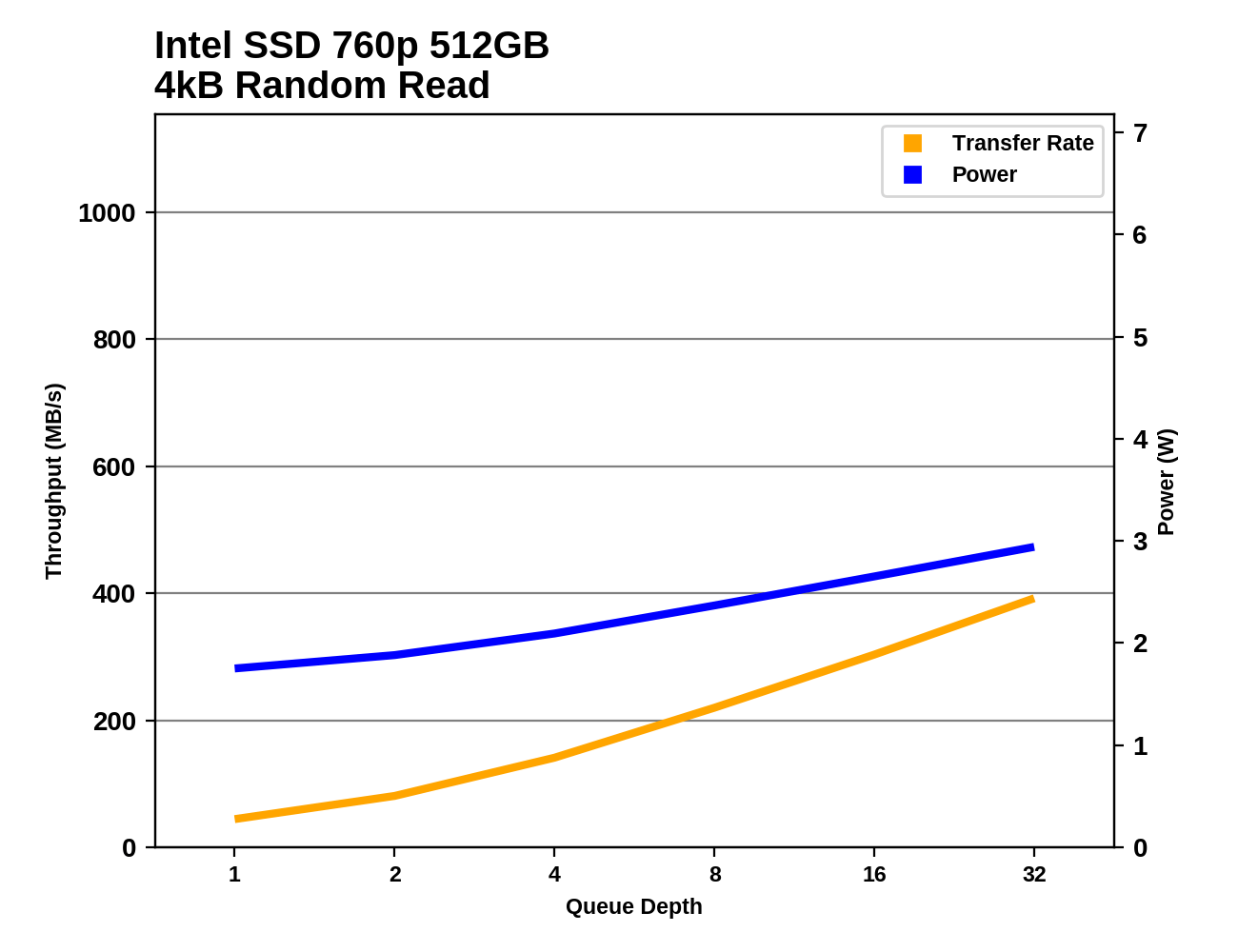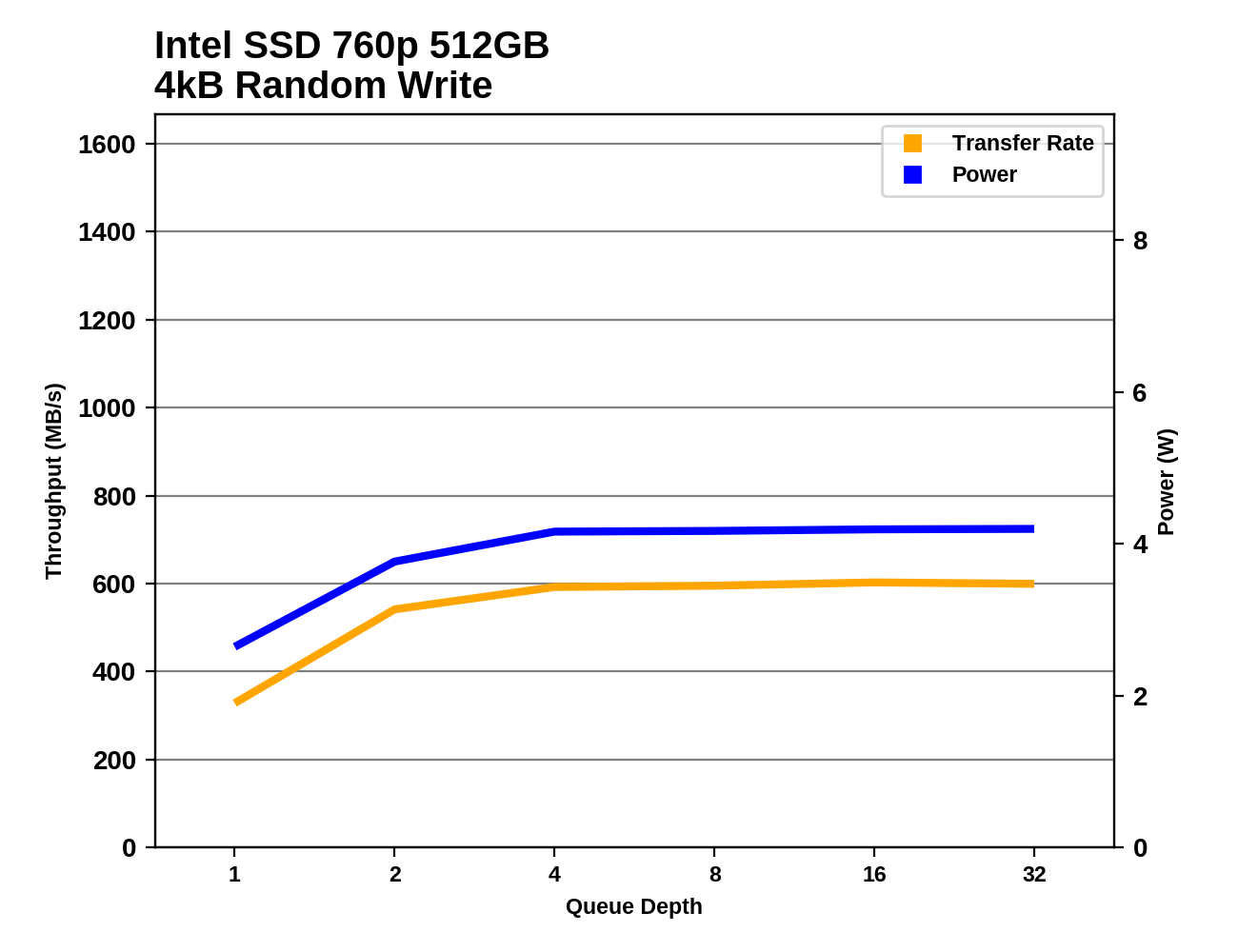The Intel SSD 760p 512GB Review: Mainstream NVMe Done Right
by Billy Tallis on January 23, 2018 11:30 AM ESTRandom Read Performance
Our first test of random read performance uses very short bursts of operations issued one at a time with no queuing. The drives are given enough idle time between bursts to yield an overall duty cycle of 20%, so thermal throttling is impossible. Each burst consists of a total of 32MB of 4kB random reads, from a 16GB span of the disk. The total data read is 1GB.

The burst random read performance of the Intel SSD 760p is great, even when compared against MLC-based NVMe SSDs. Samsung's 960 PRO is the only flash-based consumer SSD that currently beats the read latency of the 760p. The 760p has more than doubled the QD1 random read performance of the Intel SSD 600p, and is 17% faster than the Intel SSD 750.
Our sustained random read performance is similar to the random read test from our 2015 test suite: queue depths from 1 to 32 are tested, and the average performance and power efficiency across QD1, QD2 and QD4 are reported as the primary scores. Each queue depth is tested for one minute or 32GB of data transferred, whichever is shorter. After each queue depth is tested, the drive is given up to one minute to cool off so that the higher queue depths are unlikely to be affected by accumulated heat build-up. The individual read operations are again 4kB, and cover a 64GB span of the drive.

With a longer test runtime and some higher queue depths involved, the Intel SSD 760p no longer stands out from the crowd. Its sustained random read performance is reasonable given its pricing and the current field of competitors, but in a few months time it may be looking rather sluggish. The 760p is about 5% slower than the Intel SSD 750, but on the other hand it is 54% faster than the 600p.

The power efficiency of the Intel SSD 760p during random reads is about average. Samsung's SSDs dominate the top half of the chart, and the two SATA SSDs hold the top two spots, showing that the performance of NVMe SSDs still doesn't offset their increased power consumption. Intel's previous consumer NVMe SSDs are tied for last place in power efficiency: the 750 is reasonably fast but power hungry, while the 600p has more modest power requirements but is quite slow.
 |
|||||||||
The Intel SSD 760p has decent random read performance at low queue depths, but it doesn't scale well at all with higher queue depths. By QD4, Samsung's drives have started pulling away, and at QD8 and higher most drives are faster than the 760p. Even Samsung's SATA SSDs have a clear lead over the 760p before they hit the wall of SATA performance limits. At QD32, most other NVMe drives are much faster than the 760p, and the high-end drives are all at least twice as fast.
The power consumption of the Intel SSD 760p during the sustained random read test is lower than any NVMe SSD we've tested so far except the Toshiba XG5.
Random Write Performance
Our test of random write burst performance is structured similarly to the random read burst test, but each burst is only 4MB and the total test length is 128MB. The 4kB random write operations are distributed over a 16GB span of the drive, and the operations are issued one at a time with no queuing.

The burst random write performance of the Intel SSD 760p is second only to the Intel SSD 750. Since the 750 is based on an enterprise SSD platform with MLC NAND, this regression isn't at all surprising. That the 760p manages to beat the Samsung 960 PRO is quite an accomplishment. The 760p is also 73% faster than the Intel 600p on this test.
As with the sustained random read test, our sustained 4kB random write test runs for up to one minute or 32GB per queue depth, covering a 64GB span of the drive and giving the drive up to 1 minute of idle time between queue depths to allow for write caches to be flushed and for the drive to cool down.

On the sustained random write test that involves some higher queue depths, the performance of the Intel SSD 760p is good but not outstanding. Several of Samsung's drives and the Intel SSD 750 are faster. However, the 760p is on par with some of the slower MLC-based competitors and is almost twice as fast as the Intel SSD 600p.

The power efficiency of the Intel SSD 760p during random writes is a bit above average, and is substantially better than any previous Intel consumer SSD. The Toshiba XG5 and most of Samsung's recent drives are far more efficient.
 |
|||||||||
The random write performance of the Intel SSD 760p saturates around QD4 at 600 MB/s. Most high-end NVMe drives continue showing improvement up to QD8, and the Samsung 960 PRO and EVO both top out with over twice the throughput of the Intel SSD 760p. The 760p is delivering twice the performance of the Intel SSD 600p with the same power consumption, but that's one of the few comparisons where the 760p is the clear winner.










51 Comments
View All Comments
Jhlot - Tuesday, January 23, 2018 - link
Right we are comparing EVO not PRO here. And this is Intel's midrange consumer NVME now if Optane is high/enthu and 600p is low, and the 760p still doesn't compare to Samsung's lessor NVME 960 evo consumer from more than a year ago. The 960evo has a small premium in price because it can command it based on performance since no one else is stepping up to its level. Also the OEM 960 evo (PM961) is often available new on ebay for a little over $300 at 1TB which maybe the Intel offering will match. So, an altogether underwhelming showing by Intel is a valid criticism while msabercr's exaggerated Beetle vs. 911 jab which is implicit on price/offering tier not being comparable is misplaced because they are comparable consumer NVME offerings.milli - Thursday, January 25, 2018 - link
Why even compare to the 960 EVO?It barely matches the Toshiba XG5 and there's already a faster XG5-P.
andychow - Tuesday, January 23, 2018 - link
Toshiba is trying to sell their memory chip business, that's why their prices are out of whack and they have no successor. They gutted that division and leave old stock at inflated prices to pretend their brand has some sort of value. Bain must be working some sort of angle to see $18B of value.emvonline - Tuesday, January 23, 2018 - link
it has 2 dram chips? for a 512GB SSD? with average performance? is that normal?svan1971 - Tuesday, January 23, 2018 - link
Intel 50% lower performance for 33% less money than Samsung.HStewart - Tuesday, January 23, 2018 - link
And the new 960 was release today.megapleb - Tuesday, January 23, 2018 - link
Real world testing would be very helpful on SSDs. While the benchmarks are great, as a consumer, what I really care about is how much difference a drive will make to dad to day activities - boot time, application loading etc.niva - Tuesday, January 23, 2018 - link
You won't see much difference in those use cases, maybe some heavy applications might take a second or two longer to load even in the slowest drives. These drives only differentiate themselves in situations where you hammer them with tons of data and instructions.bug77 - Tuesday, January 23, 2018 - link
And that's the "dirty" secret of SSDs: as much as benchmarks show them performing faster or slower, in real life it makes little difference unless your workflow relies on heavy I/O. I can confirm that as I have currently installed Vertex4, 850EVO and MX300 drives and I cannot tell of any difference when using any of them.I've said it before and I'll say it again: when buying an SSD, the only rule to follow is "get the biggest drive you can fit in your budget".
Amandtec - Wednesday, January 24, 2018 - link
Contrarian view: A PC is as much a status symbol as a tool. By your logic no one should buy a BMW because you unlikely to use all that extra speed.